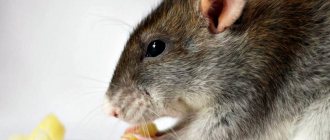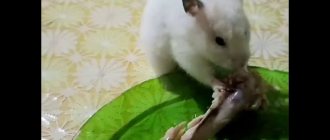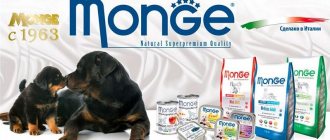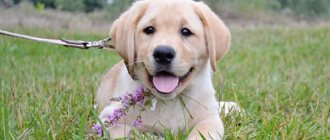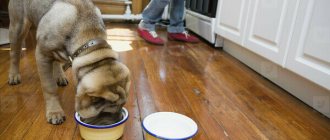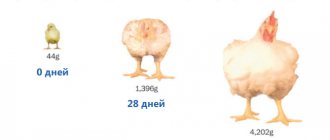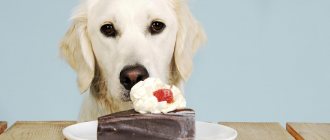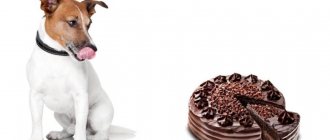The dachshund is a type of hunting breed.
This is a very ancient breed of dog and there is still controversy surrounding its origin.
Nowadays, she has found a calling not only in hunting.
Nowadays, dachshunds of various types exist without problems next to people in big cities, in apartments or in the yard. Raising and caring for pets is quite simple.
These are cute and friendly animals with whom it is not difficult to find a common language.
What to feed – natural food or artificial food?
Every owner of a dachshund sooner or later faces the question: what food to choose - natural food that you have to prepare yourself, or take it from the store shelf?
Each type of food has its pros and cons..
Which one to choose is entirely the owner’s decision, but we must not forget about what is best for the dog. Every breed of dog can develop food allergies, and the Dachshund is no exception.
Changing one product to another is much easier than completely switching a dog to another brand of commercial food.
But at the same time, artificial food is much more practical and convenient to use than natural food, because you have to prepare it yourself, observing a strict ratio of products.
The choice of food for a dachshund should be strictly individual. If the breeder fed your puppy artificial food before you, think about whether it is worth exposing the puppy’s body to stress and changing the type of food? This principle also works in the opposite direction.
Feeding a dog natural food is expensive both in terms of money and time . But, on the other hand, in order to choose the right commercial food, you will also have to go around more than one store shelf.
Expert opinion
Tolkachev Andrey Mikhailovich
veterinarian
“The issue, as usual, is controversial, because it is impossible to come to a common opinion. Each owner, to the best of his ability and time, chooses the appropriate food. People who specialize only in breeding dachshunds choose natural food. For working and busy dachshund owners, it makes more sense to buy food from store shelves. The main thing in natural nutrition is to maintain all the necessary proportions, and in artificial nutrition, choose only high-quality food. In this case, the dachshund will develop fully - there is no need to think about how the dachshund will lose weight or gain weight.”
Reviews
Andrey, Belgorod
“When I adopted the puppy, the breeder advised me to feed him Hill's food. I decided to try it and was pleased with its quality. Robie is active, healthy and handsome. Besides, eating this way doesn’t give me any trouble.”
Varvara, Chelyabinsk
“At first I fed Bella food. I bought meat, cereals, and dairy products. But then I realized that giving food is much easier. Moreover, the quality is not inferior to meat and dairy dishes.”
General recommendations for healthy eating
Only by following proper nutrition can a dog be healthy and active. The way a dog eats affects its growth and development, as well as its life expectancy, and it also determines whether it receives all the vitamins.
In order for the animal to be happy and healthy, you need to follow certain feeding rules.:
- Follow your dog's feeding schedule. Eating should be strictly at the same time every time, and the amount of food in the bowl should be sufficient, but not excessive. Do not forget to remove uneaten food from the bowl - it will spoil.
- Create your pet's menu correctly. If you choose natural feeding, remember that the diet should contain about 50% meat. The rest should be vegetables, cereals, fermented milk products, and sometimes fish. If your choice falls on artificial food, then before choosing, consult a veterinarian, he will help with advice.
- The composition of the products should be such that the dog receives all the necessary proteins, fats, carbohydrates and other vitamins and minerals.
- Dachshunds should not overeat. The breed is prone to obesity, for this reason, do not allow the dog to eat too much. If there is food left in the bowl, start putting less of it.
- Make sure your diet is multi-component and varied. You cannot feed your dachshund only fish or meat. Be sure to add vegetables, cereals, and dairy products to the menu. Don't forget about tasty rewards for your pet. You shouldn’t mix natural and artificial nutrition either - choose one.
- Don't forget about vitamins. With natural nutrition, there is a high probability that the dog will not receive all the necessary elements. Go to the veterinarian and get advice on what vitamins you should give your animal.
Don’t forget to take into account your pet’s breed when choosing food - there are specialized foods for dachshunds . Also, knowing the weight of the animal will greatly facilitate the process of dosing food.
Basics of a proper table
Already in the very approach to a dog’s diet, the views of their owners differ. Some believe that a pet needs to receive exclusively natural products and its nutrition is no different from human nutrition. Other owners trust food manufacturers more and prefer to simply pour puppy food out of a pack. Both approaches are possible, because both natural food and specially developed dog food contain a sufficient number of useful elements and vitamins.
When purchasing this hound breed, it is recommended to temporarily leave the same regime and table that the breeder had. This way you will eliminate unwanted allergies and help your baby adapt to a new place. Then gradually begin to accustom the animal to a new diet, which you plan to follow throughout its life.
Pros and cons of natural food
Feeding natural food has its advantages and disadvantages.
pros:
- The dog receives fresh vitamins and components;
- You know exactly what foods your dachshund eats, and you are also aware of their quality and freshness;
- Natural nutrition is closer to “natural”, the way a dog would eat in nature;
- This is an excellent replacement for artificial ones if the dog is allergic to it. You can easily replace the allergen;
- Natural food, despite all the controversy surrounding it, is more nutritious and healthy, because it uses natural food without fillers, dyes and preservatives.
Minuses:
- High price;
- It will take a lot of time and effort;
- It is necessary to observe a certain norm and ratio of vitamins and elements. Without this, the dog will start to get sick;
- You should always remember what foods you should not give.
List of permitted and prohibited products
Natural feeding has its own nuances. We must keep in mind what can be given to a dachshund, and what is better left prohibited.
List of approved products:
- Chicken, turkey, rabbit, beef, veal;
- Sea fish without bones;
- By-products (beef tails and tripes, lungs, heart, liver, chicken feet, beef cartilage);
- Cereals – buckwheat and rice. You can add rye or wheat bran;
- Vegetables and fruits (fresh or boiled zucchini, carrots, cucumbers, all types of cabbage, apples);
- Low-fat cottage cheese.
List of prohibited products:
- Salted and smoked;
- Whole milk, cream and butter;
- Pork and lamb;
- Raw river fish;
- Sweet;
- Food from the table;
- Exotic fruits;
- Oatmeal;
- Ground meat;
- Tubular and fish bones.
Industrial feed
This type of food also has its pros and cons.
Advantages:
- The food is sold ready-made;
- No need to waste time on preparation;
- These foods have a varied composition, you can choose according to your dog’s taste;
- Artificial food is already completely balanced, the dog receives all the necessary vitamins;
- There are foods specifically for dachshunds;
- Premium food and higher do not pose any harm to the health of the animal.
Flaws:
- There is no guarantee that the packaging contains the correct composition of the product;
- The composition contains various flavoring additives, emulsifiers and preservatives;
- Incorrectly selected food will cause allergies;
- Cheap food does not contain meat, but soy and low-quality by-products. This provokes diseases.
NOTE!
Many breeders still prefer artificial food, believing that it is a complex of all the vitamins necessary for a dog.
There are also two types of industrial feed - dry and wet. Some owners choose just one, but the best option is to combine them.
For example, a dog receives wet food for breakfast and dry food for lunch. This is a great way to maintain water balance in the animal's body .
Plus, dry food lasts longer, and you can easily remove the bowl if the animal does not finish the food and leave it for the next meal.
As already mentioned, there are specialized foods for dachshunds:
- Summit food;
- ANF Holistic food;
- Farmina N&D food;
- Guabi Natural food;
- Wolfsblut dry food.
There are 4 classes of dog food - economy, premium, super premium and holistic . The best food for dachshunds should be super premium or holistic.
Is it possible to feed economy class food?
Such feed is not at all beneficial to the health of animals . They often lack meat and all the vitamins and minerals that dogs need. But there are plenty of flavor enhancers and preservatives.
All meat is replaced with soy and offal . Such food is absolutely useless and to some extent dangerous for a dog of any breed, not like for dachshunds.
IMPORTANT!
Economy class feed brands: Stout, Trapeza, Our Mark, Friskies, Pedigri, Cesar, Darling, Chappi, Oscar.
Dry food
Dry food is the undoubted favorite of many owners . There is a wide variety of it on store shelves, but only the highest classes are suitable for dachshunds - super premium and holistic.
Premium food rating:
- Pro Plan;
- Royal Canin;
- Probalance;
- Advance;
- Brit Premium;
Premium food is far from ideal and is not suitable for everyday feeding. They are also based on by-products, and although there are more vitamins than in economy class food, they are still not enough.
Super premium food rating:
- Brit Care;
- Pronature Original;
- 1st Choice;
- Josera;
- Fitmin;
- Monge;
- Dukes Farm.
Rating of holistic feeds:
- Orijen;
- Savarra;
- Canidae;
- Grandorf;
- Now Fresh;
- Acana.
The last two classes of food are the most expensive, but by choosing them, you can be sure that the dog will not only be healthy, but will also receive all the necessary elements for health.
Feeding the puppy
1 month
Once your puppy is one month old, it is already allowed to give complementary foods. These can be boiled vegetables, such as carrots. Complementary feeding with rice and semolina milk porridges is also allowed.
You should feed 4-5 times a day, taking a break of 3-4 hours.
2 months
When the puppy turns 2 months old, the nutritional diet needs to be expanded. The dachshund can now be given boiled meat - chicken, turkey or lean veal.
It is worth remembering that you cannot give meat every day, once a week is enough . Once every two weeks you can give one raw face along with it. Feeding frequency should be the same as last month.
3 months
At three months, meat can be given a little more often and even raw, and not just boiled . It should be introduced together with grated vegetables and herbs. The number of meals at this age should be reduced to four.
This is a period of active growth, so make sure your puppy gets enough calcium. The source is special calcined cottage cheese, which you can prepare yourself.
You need to feed your baby Dachshund little and often so as not to overload the small stomach, which nevertheless quickly becomes empty..
By ten months, the dachshund is already an adult, so the number of feedings should be reduced to two per day, and the diet should become normal if you use natural food.
This is achieved by slowly introducing all necessary products into the menu and gradually reducing the number of meals.
It is necessary to feed the puppy before a walk, as dachshunds quickly need to empty their intestines.
Vitamins for dachshunds
Dachshunds are often deficient in phosphorus and calcium, and their skeletal features require active joint protective supplements (glucosamine). Proven complexes for dachshunds:
8in1 Excel Calcium (Calcidee)
Based on the balance of phosphorus, calcium and vitamin D, it combines well with other complexes, in some cases it is recommended to be fed along with dry food. Suitable for puppies, pregnant and lactating bitches.
8in1 Pervinal Excel Puppy Multi Vitamin
A complete complex of 12 vitamins and 10 minerals, suitable for rapidly growing dogs.
8in1 Excel Glucosamine
Chondroprotector, contains glucosamine and chondroitin, which protects the cartilage of the intervertebral joints, as well as the joints of the limbs, from destruction.
Feeding an adult dog
When creating a diet for an adult dog, you need to remember that overfeeding leads to obesity, which, in turn, causes additional diseases - heart, skin and excretory system diseases.
But it is harmful for a dachshund to starve. Her immunity decreases, and again, she becomes vulnerable to viruses and bacteria.
Breeders and veterinarians advise giving dachshunds not pulp, but meat waste - cartilage, wings, heads and other offal . The diet also includes porridge, vegetables, cottage cheese and sometimes fruits.
An adult Dachshund needs to be fed twice a day, but snacks are allowed as rewards during training.
Dachshunds are very cunning dogs; they will beg you for food in any way possible . In this matter, you need to show willpower and not succumb to their pitiful gaze.
Diet composition
A dog's diet is different from a human's. Some foods we eat can cause irreparable harm to a dog. That is why every owner should know what to feed their dachshund.
Meat
Meat should be present in the diet daily. About one third of all food consumed should be meat.
It is better to give preference to lamb, turkey and lean beef. Fatty meat, especially pork, is very harmful as it can cause stomach upset. Well, chicken meat, especially the skin, in some cases, can provoke allergic reactions. Any meat must be boiled before serving, but if you can be one hundred percent sure of its quality, it is offered to be tasted raw.
For those who want to know how to feed a dachshund correctly, it is better to familiarize yourself with some of the nuances. For example, it is better to offer a dog not tender tenderloin, but stringy, coarse meat. This not only activates the functioning of the gastrointestinal tract, but also trains her jaw and strengthens her teeth, because she tears off pieces and chews them.
Kidneys, liver, brains and other offal are an excellent source of vitamins, enzymes, proteins, but they can be offered to your pet only after 4 months of age. In this case, the portion is increased gradually due to the risk of allergies.
Fish – is that really what dachshunds eat? Yes, this is also meat, but in the daily diet there should be twice as much of it as, for example, turkey. Sea fish is an excellent solution; its meat easily separates from the bones.
It is better to boil the fish first. Boiled river fish can also be offered to the dog, but first it is passed through a meat grinder several times to grind the bones.
It should be noted that it is strictly forbidden to give bones to dogs; they can cause many intestinal diseases!
Cereals
Almost half of the dachshund's daily diet consists of various cereals: rice, buckwheat, oats, rolled oats. They are rich in microelements, promote good functioning of the gastrointestinal tract and saturate the body for a long time. Moreover, it is better not to give porridge from legumes and semolina. The first can lead to bloating, and the second - obesity.
When preparing porridge, it is better to periodically change its composition, that is, the types of cereals. This will help diversify your food and enrich the body with various microelements. Hercules porridge can be steamed with boiling water rather than boiled. But pearl barley is absorbed by only 30-40 percent.
Vegetables and fruits
It’s impossible to imagine, but the dog loves fruit very much. She eats apples, pears, bananas and dried fruits with great pleasure. Fruits containing vitamins for the dachshund are not only healthy, but also clear plaque.
It is not recommended to give your pets exotic fruits or treats that belong to the group of allergens. These are strawberries, citrus fruits, as well as strong-smelling greens - cilantro, celery. If your furry friend really wants to try something exotic, then you can give it very little and infrequently.
You can replenish your supply of vitamins with scalded nettles, dandelions or sprouted oats. It should be noted that fruits and vegetables are rich in fiber, which is so necessary for the normal functioning of the human intestines. But, unfortunately, it cannot be digested by the body of predatory animals.
Therefore, before feeding your dachshund vegetables, you should chop or grate them. But even in this form, the dog is reluctant to eat the offered dishes. Vegetable oil added in small quantities will help make them a little more appetizing. Another way to increase the digestibility of vegetable dishes is heat treatment. But as a result, a colossal amount of useful substances is destroyed.
Therefore, it is best to combine raw and stewed-boiled cooking options. Vegetables can be boiled whole, then chopped to a puree consistency.
Every owner who is puzzled about what to feed his dachshund should know that it is better to boil or stew potatoes. It is also not recommended to give cabbage raw; it causes fermentation in the stomach. Well, the maximum share of vegetables and fruits in the daily diet is 40%.
Milk and eggs
The main diet of a dachshund puppy consists of dairy products. In its main form, milk is given to babies up to 4 months. Then, it is replaced with products such as kefir, yogurt, cottage cheese, cheese, fermented baked milk, and yogurt. They contain useful minerals, vitamins and proteins, which are so necessary for the normal functioning of the animal. Milk is added to porridge after the cereal has already been boiled. Well, sour cream is an overly fatty ingredient, so its consumption should be limited.
Eggs, rich in vitamins and protein, are still not digestible by dachshunds in their raw form, so it is better to boil them or make an omelet. You can supplement your weekly diet with them, but in limited quantities - no more than two pieces. One quail egg per day is what you are allowed to feed your dachshund puppy. It is also recommended to enrich the diet with them during pregnancy. But you need to remember about the possibility of an allergy to protein.
Seafood
In addition to fish meat, the following types of seafood of animal and plant origin can be used for cooking:
- squid;
- mussels;
- crabs;
- seaweed;
- seaweed.
These products are indispensable during the period of vitamin deficiency; they are a storehouse of vitamins, minerals, especially iodine. The quality of your pet's coat is noticeably improved by adding a small amount of seaweed to its food. But you should also remember about the possibility of allergic reactions.
Bread, sugar, salt
Before feeding an adult dachshund, you should remember that excess sugar and salt are very harmful even to humans. Dog dishes should be very under-salted, and sugar should be completely excluded from consumption or replaced with simple carbohydrates - fructose, glucose, honey.
It is strictly forbidden to give furry pets ice cream, condensed milk, sweet cottage cheese or other sweets.
It is better to replace soft white bread with rye crackers. Cookies, pastries, and muffins will not bring any benefit to your pet’s health; they are high in calories and too sweet for him.
Vegetable oil, nuts, seeds
A small amount of vegetable oil can be used to season various dishes. This is a good way to regain your appetite, but don't overdo it. They like sunflower, corn or soybean oil.
Hulled seeds or nuts are an excellent source of amino acids and vegetable fats. Occasionally you can give such a treat.
Sample menu for the week
| Day of the week | Morning | Evening |
| Monday | Raw rabbit meat, cereal in milk, grated raw carrots. | Raw beef, cereal, grated raw zucchini and vitamins. |
| Tuesday | Lean lamb, half a glass of fermented baked milk, grated apple, porridge. | Boiled liver, rice porridge, boiled chopped pumpkin, finely chopped greens. |
| Wednesday | Boiled fish (pollock), rice porridge, boiled cauliflower, chicken yolk. | Raw or cooked beef, vegetables and porridge. |
| Thursday | Raw beef tripe, rice porridge, stewed cauliflower, grated pear, organic yogurt. | Low-fat cottage cheese with vitamins, grated cucumber and millet crackers. |
| Friday | Raw chicken hearts, semolina porridge, tomato and juice. | Raw sprat, buckwheat, stewed zucchini and greens. |
| Saturday | Beef, boiled pink salmon, oatmeal, grated walnuts, stewed cabbage with tomatoes. | Ryazhenka, beef biscuits and beef bone. |
| Sunday | Raw chicken breast, porridge, greens and apple. | Raw rabbit, porridge, grated pumpkin and greens. |
Porridge
There is debate about the benefits of cereals. However, the number of fans of buckwheat and rice is not decreasing. Porridge is steamed in water and served warm along with meat, kefir, and fermented baked milk. Hercules and millet are practically not absorbed by the dog’s body, and semolina is too fatty.
Porridge is given mainly in the cold season. A dog should eat no more than 20% of the entire portion of buckwheat and rice per day.
In summer, vegetables are used instead of porridge. To add flavor and increase their beneficial properties, chopped herbs – parsley and dill – are added.
What is strictly contraindicated
Despite the fact that there are prohibited foods, there is also a list of what dachshunds are strictly contraindicated from eating.:
- Sausage product. They contain saltpeter, which will cause cancer in your pet.
- Chocolate. The dog can be poisoned by it.
- Rabbit and chicken bones. They are essentially tubular, which means they can injure a dog’s mouth with a splinter.
- Fried and smoked food. Such food can have a negative effect on the human body, let alone dogs.
Breed Features
Despite their short legs and unusual cute appearance, dachshunds are born burrow hunters with increased attentiveness, instant reaction and a balanced nervous system. An adult dog is distinguished by a calm character, impeccable obedience and submission to the will of the owner. Thanks to his extraordinary intelligence, this cute pet has been a favorite of many families for several centuries.
IMPORTANT!!! Dachshunds were favorites of Napoleon Bonaparte, who, when dying, left orders to bury the bodies of the adorable dogs in his grave.
The small dog has a loud voice, its menacing bark sounds scarier than that of many large breeds of dogs. A properly raised pet will not lunge at people or animals for no apparent reason. Despite its short stature, the animal copes well with the functions of a guard and protector of the family.
